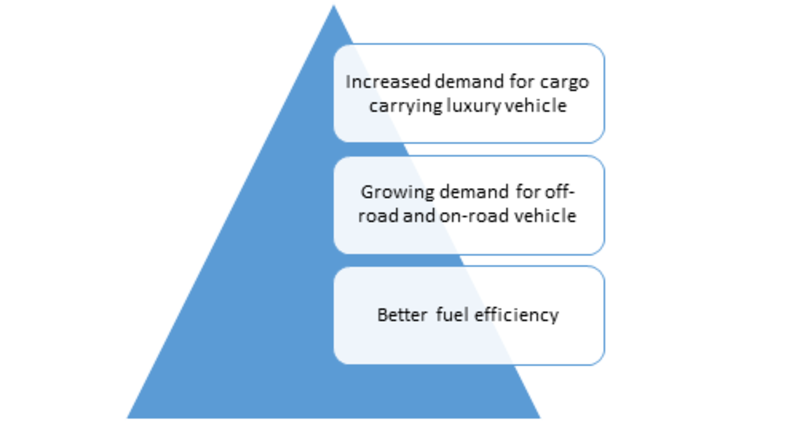Pune, India, Dec, 2018 /MRFR Press Release/- Market Research Future published a half cooked research report on Global Crossover Vehicles Market. The global crossover vehicles market is expected to witness ~7.82% CAGR during the period, 2024 to 2032.
Crossover Vehicles Market Highlights
Crossover vehicles are also known as crossover utility vehicle (CUV), in which the body is built directly on a car platform. The crossover vehicles are designed for light off-road vehicle activity and holding similar features to hatchback or station wagon such as rear liftgate door and fold-down rear seats.
Rising demand for off-road and on-road application in the same vehicle will increase the demand for crossover vehicles during the forecast period. Better fuel efficiency, as well as great vehicle comfort, makes it more attractive in the global market for the crossover vehicles. The crossover vehicles use the front wheel, rear wheel, and all-wheel drive which enhance the cargo carrying capacity of the vehicle. The designing and features of crossover vehicles are borrowed from hatchback and station wagon, such as wide space for cargo at the back of the vehicle, which increase the demand for the crossover vehicles in the global market. Fleet owners are primarily focused in the manufacturing of crossover vehicles owing to increased demand for a luxury look and high cargo carrying capacity in the vehicle. Increase spending of the consumers for vehicles in the global market will further fuel the growth of the global crossover vehicles market during the forecast period. Manufacturers are investing in the research and development for the better vehicle comfortability and reducing the overall cost of the vehicle. However, the high price of the crossover vehicles will hamper the growth of the global crossover vehicles market.Browse In-depth Details [Table of Content, List of Figures, List of Tables] of Crossover Vehicles Market Research Report
Drivers: Crossover vehicles

Market Research Analysis
In terms of region, the global market for the crossover vehicles is segmented into North America, Europe, Asia-Pacific, and the Rest of the World. Asia-Pacific is estimated to hold the highest revenue market share in the base year and expected to dominate during the forecast period followed by North America and Europe. Presence of China, Japan, India, and South Korea where a continuous increase in the demand for the crossover vehicles owing to increased purchasing power as well as increased in the average disposable income are expected to drive the growth for the automotive crossover vehicles market in Asia-Pacific. In North America, the US and Canada will primarily drive the growth for mid-size and large crossover vehicles. According to the U.S. Energy Information Administration, the sales of crossover vehicles will exceeds the sales of light-duty vehicle cars in the near future. In Europe, there is increase in the sales of luxury crossover vehicles and the presence of top manufacturers such as Volkswagen Group, is expected to boost the sales for the crossover vehicles. The rest of the world consists of the Middle East and Africa and South America. The Middle East and Africa is expected to dominate the market in the base year and during the forecast period.
Scope of the Report
This study provides an overview of the global crossover vehicles market, tracking three market segments across four geographic regions. The report studies key players, providing a five-year annual trend analysis that highlights market size, volume, and share for North America, Europe, Asia-Pacific, and the Rest of the World. The report also provides a forecast, focusing on the market opportunities for the next five years for each region. The scope of the study segments the global automotive crossover vehicles market by type, drive type, fuel type, gear transmission, and regions.
By Type
- Small Size Crossover
- Mid-Size Crossover
- Large Size Crossover
By Drive Type
- Front Wheel Drive
- Rear Wheel Drive
- All-Wheel Drive
By Fuel Type
- Petrol
- Diesel
By Gear Transmission
- Manual
- Automatic
By Region
- North America
- Asia-Pacific
- Europe
- Rest of the World
Key Players
The prominent players in the global crossover vehicles market include Honda Motor Company, Ltd. (Japan), Ford Motor Company (US), Nissan Motor Company Ltd, (Japan), Mazda Motor Corporation (Japan), and Toyota Motor Corporation (Japan). Subaru of America, Inc. (US), Kia Motor Corporation (South Korea), FCA US LLC (US), Volkswagen (Germany), and Volvo Cars (Sweden) are among others.